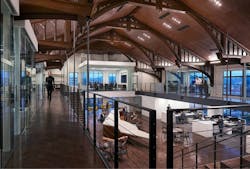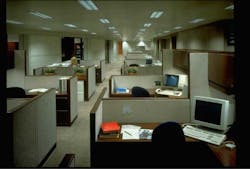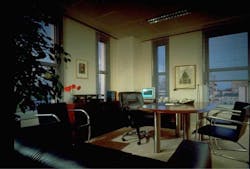A sense of place is a long-standing concept. At a grand scale, this has manifest in walled cities and specific architectural traditions. This parallels rituals, traditional garb and dress, and regional cuisines in defining cultures. With the exception of a few very high-level executives, this desire to develop a sense of place seemed to have been lost at the end of the last century in corporate culture. Recently however, we’ve seen a shift: more, and more, companies are emphasizing the importance of creating a meaningful sense of place in the office environment for all of their employees.
Today, we don’t just talk about the importance of opportunity, salary and benefits in bringing top talent into our professional organizations—we also highlight the importance of the workplace itself. Investment banks and consulting firms are competing with tech firms for top analytical talent and companies in all three industries are using the workplace as one symbol of the company’s commitment to its employees. In our recent 2016 U.S. Workplace Survey, Gensler discovered that staff in the consulting/accounting industry report more choice in where they want to work (34 percent), which is higher than the average U.S. employee (27 percent).
I find this shift is fascinating. When I joined the professional class, after graduating from college, the world was still focused on wood paneled, large offices tailored for a few, high-level individuals and office and workstation “scraps” for the remainder of us. Half-way through my first year, and during the initial “go-go” years of the 80s and before the ’87 crash, the investment banking firm where I worked was growing and taking additional space in their headquarters building in lower Manhattan. Graciously, they moved my analyst class to a floor in a different elevator bank that was under construction. For the remainder of that year, the 10 of us were the only staff on the 7th floor sitting amidst scaffolding, hanging plastic dividing off the dusty construction, and butcher paper “carpet” taped on the floor. It was ‘start-up chic’ before start-ups were a thing.
Later, in business school, the idea of the workplace design was a non-topic amongst seemingly more important topics, such as supply chains, organizational systems and cost accounting. From the business school perspective, we weren’t yet talking about design, and design thinking of physical space. An office was intended to be a nice and respectful place, but not really a place that created a statement or helped to recruit.
My own career evolution mirrored the changes that we were seeing in the workplace. In Northern California, I went from a newly built corporate headquarters (with a grand private office) at Dreyer’s Ice Cream Oakland headquarters, to a small converted art gallery space on Union Street in San Francisco, to a converted library in San Francisco’s Presidio at the start of its renewal and the start of “hackable” buildings. I’ve been without an office much longer than most of my business school classmates and I’ve seen and felt the impact that place can have in our worlds.
For the past 12 years, I’ve been a fortunate outsider, a non-designer in the world’s largest design firm. As a leader in our Consulting practice area, I have been directly engaged in helping other organizations recognize the long-standing value of place. I have witnessed how customers, guests and employees move through the spaces that we design. I have observed where we can create positive and incidental interactions and where we end up with bottlenecks and creative dead-ends.
Through it all, my appreciation has grown for my colleagues’ role in defining the envelopes of where life occurs. Each day, we are striving to use design, and specifically design of the built environment, to improve our world. Buildings have a permanence and the responsibility is significant. Everyone in the world touches something that an architect or designer envisioned. The grace of an elegant design can elevate, and a poorly envisioned space can oppress.
Today, I am sitting in temporary space while our new Los Angeles office is being built with a great focus on placemaking. Unlike 30 years ago, I am working at a time where space and a sense of place is being recognized for the power that they have in improving the world.
About the Author
Gensler
A global design firm with more than 5,000 practitioners networked across five continents, Gensler features insights and opinions of architects and designers on how design innovation makes cities more livable, work smarter, and leisure more engaging. Our contributors write about projects of every scale, from refreshing a retailer’s brand to planning a new urban district, all the while explaining how great design can optimize business performance and human potential. For more thought leadership and blog content, visit our Research & Insight page. Follow us on Facebook, LinkedIn, and Twitter.


